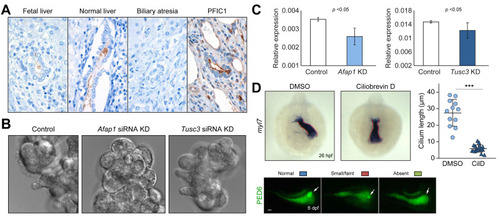Fig. 5
- ID
- ZDB-FIG-240307-9
- Publication
- Glessner et al., 2023 - Biliary atresia is associated with polygenic susceptibility in ciliogenesis and planar polarity effector genes
- Other Figures
- All Figure Page
- Back to All Figure Page
|
(A) Immunoperoxidase staining of Arl13b, which is expressed in primary or motile cilia shows luminal staining in 18-week-old human fetal liver, normal human liver, and liver disease-control (primary familial intrahepatic cholestasis type 1, PFIC1). Arl13b staining is absent in livers with BA. (B) Panels from left to right show mouse tracheal cell cultures before (left) and after treatment with Afap1 siRNA and Tusc3 siRNA. Treated cultures do not demonstrate the normal distribution of motile cilia seen in untreated cultures (Video S1). (C) The relative expression of Afap1 and Tusc3 in mouse tracheal epithelia cell cultures shows the effectiveness of KD after siRNA transfection (Video S2 and Video S3). (D) CilD treatment impairs left-right asymmetry and hepatic biliary function in zebrafish. Upper left. Whole-mount in situ hybridization images showing myl7 expression in cardiomyocytes at 26 hpf. The embryos were treated with 5 μM CilD from 8 to 26 hpf. Dotted lines outline the heart. Two patterns of heart looping (normal and midline) were observed. Lower left panels. Epifluorescence images showing PED-6 accumulation in the gallbladder (arrowheads). The larvae were treated with 2.5 μM CilD from 3 to 6 dpf. Based on PED6 levels in the gallbladder, larvae were divided into three groups: normal, small/faint, and absent. Right panel. The length of cilium in cholangiocytes was significantly reduced in CilD-treated larvae (n = 6) compared to controls (n = 4) at 6 dpf. CilD, ciliobrevin D; Dpf, days post fertilization; Hpf, hours post fertilization; KD, knockdown; siRNA, small-interfering RNA. |
Reprinted from Journal of hepatology, 79(6), Glessner, J.T., Ningappa, M.B., Ngo, K.A., Zahid, M., So, J., Higgs, B.W., Sleiman, P.M.A., Narayanan, T., Ranganathan, S., March, M., Prasadan, K., Vaccaro, C., Reyes-Mugica, M., Velazquez, J., Salgado, C.M., Ebrahimkhani, M.R., Schmitt, L., Rajasundaram, D., Paul, M., Pellegrino, R., Gittes, G.K., Li, D., Wang, X., Billings, J., Squires, R., Ashokkumar, C., Sharif, K., Kelly, D., Dhawan, A., Horslen, S., Lo, C.W., Shin, D., Subramaniam, S., Hakonarson, H., Sindhi, R., Biliary atresia is associated with polygenic susceptibility in ciliogenesis and planar polarity effector genes, 1385-1395, Copyright (2023) with permission from Elsevier. Full text @ J. Hepatol.

